
Introduction
Generative Pre-trained Transformers (GPTs) have made great progress in the field of Artificial Intelligence (AI), changing the way we use technology. These advanced AI models can understand context, create text that seems human-like, and learn from their interactions - making them more and more important in different applications.
GPTs, also known as custom ChatGPTs, are a specialized version of ChatGPT. Created for interactive conversations, they have the capability to mimic human interactions and provide chat responses. This makes them extremely useful in areas such as customer service, technical support, and even companionship.
But there's something interesting about these amazing technologies that people don't always notice: Customization. Yes, you heard it right! Now you can make your own special AI models without knowing any code.
In this article, we will discuss GPTs (Custom ChatGPTs) and how you can utilize the innovative tools provided by OpenAI to create your unique models. Whether you are an AI enthusiast eager to explore new concepts or a business owner striving to improve your customer service, this guide will offer insightful ideas about GPTs.
Let's get started exploring this cool world and see what we can do with customized AI using GPTs!
While you're here, why not also take a look at our comprehensive review of the top GPTs on the market? We have evaluated each tool based on its features, ease of use, and value for money. This will help you make an informed decision when choosing the GPT that best suits your needs. Let's dive in and discover the endless possibilities that await with these incredible AI assistants.
Understanding GPT Builder
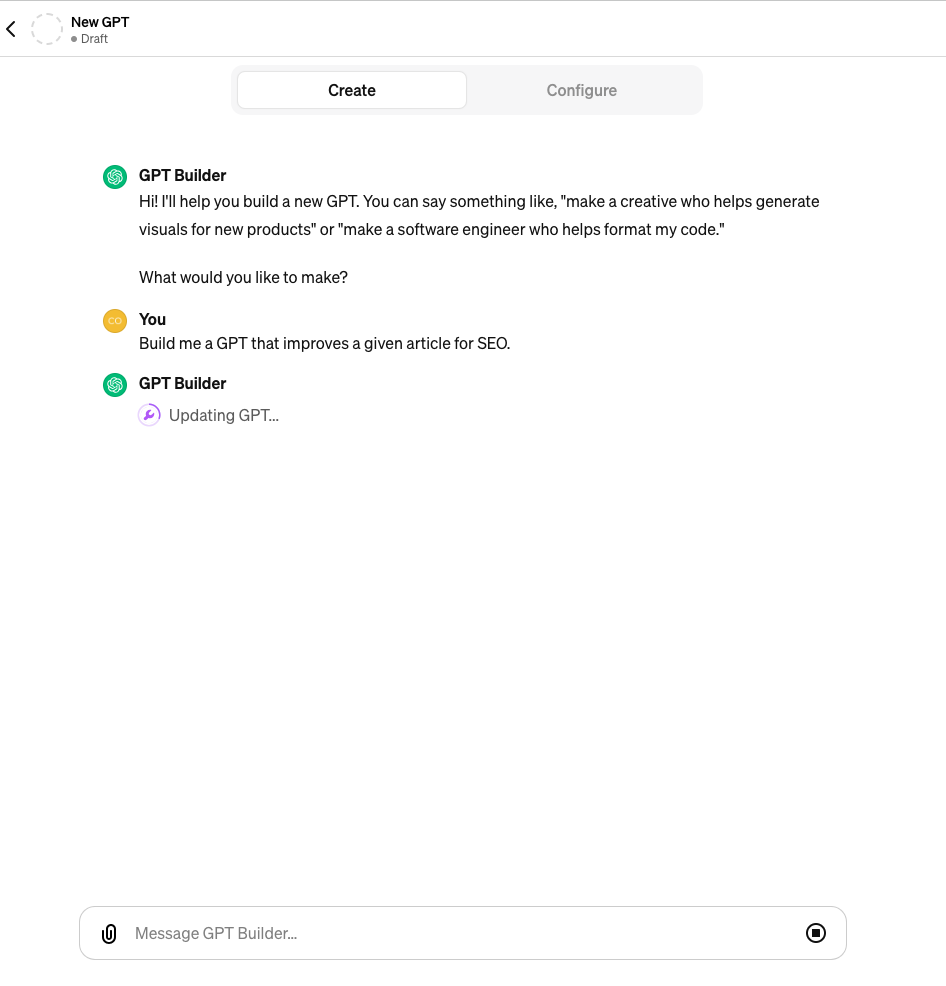
As we explore Generative Pre-training Transformers (GPTs), we often come across the term GPT Builder. But what exactly is it? In simple terms, GPT Builder is a tool that helps you create your own customized ChatGPTs without any coding skills. It plays a crucial role in making AI accessible to everyone, regardless of their technical expertise.
GPT Builder: A Platform for Creating Custom ChatGPTs Without Coding
Imagine having the ability to build your own AI model that can perform specific tasks based on your requirements. That's exactly what GPT Builder allows you to do. This innovative tool not only simplifies the process of building custom ChatGPTs, but also gives you control over the personality, capabilities, and other settings of your AI model.
But how does it actually work? Let's take a closer look.
How to Use GPT Builder: Step-by-Step Guide
Creating a custom ChatGPT with GPT Builder involves the following steps:
- Log in to ChatGPT: Navigate to the GPT Builder at https://chat.openai.com/create.
- Define the Purpose of Your GPT: The first step is to determine what role you want your custom GPT to play. Do you want it to act as a personal finance advisor, an SEO expert, or maybe a project manager? Your vision will guide the development process.
- Specify the Scope: Once you have a clear idea of your GPT's purpose, define its scope. This means identifying the specific tasks your AI model will handle and the type of conversations it will engage in.
- Choose the Abilities: Next, choose the abilities you want your custom GPT to have. For example, if you're creating an SEO expert GPT, you might want it to analyze website traffic data and provide SEO recommendations.
- Refine and Test: After selecting the abilities, refine your model through testing and gathering feedback. This step is crucial in ensuring that your GPT performs as expected.
- Deploy and Integrate: Finally, deploy your custom GPT and integrate it with your desired platform or system.
Throughout the entire process, GPT Builder's user-friendly interface provides a smooth experience. You don't need any coding knowledge – instead, you'll be guided through each step with clear instructions.
Customizing Your GPT: Configuration Options
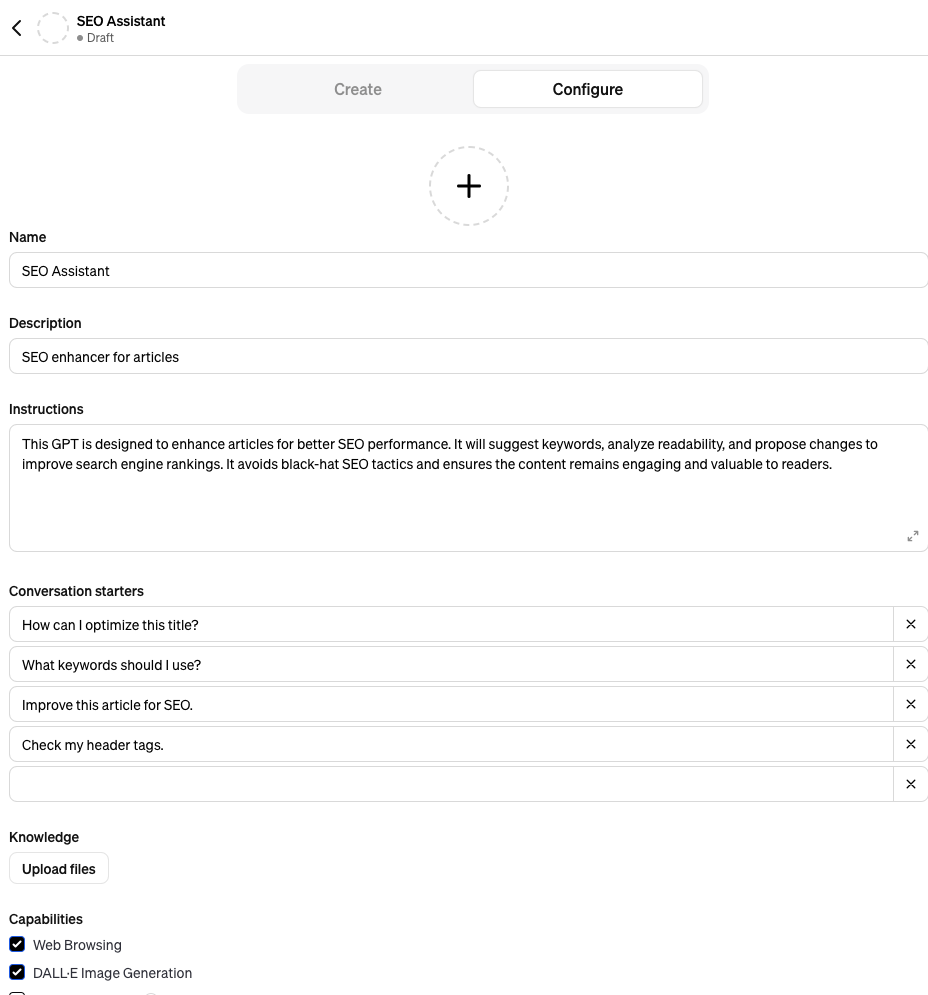
GPT Builder offers various configuration options to personalize your AI model. You can customize its identity (name, avatar), abilities (knowledge base, additional functions like web browsing or image generation), and conversation starters.
As you experiment with different configurations, remember that creating a custom GPT is an ongoing process. Don't hesitate to go back to any step and make adjustments until your model meets your requirements perfectly.
Monetizing and Accessing GPTs through the GPT Store(Not Yet Available)
Once you've successfully created and fine-tuned your customized chatbot using GPT Builder, you might be wondering how to make it accessible to a broader audience. This is where the GPT Store comes into the picture.
What is the GPT Store?
The GPT Store, though not yet available, is envisioned as a robust marketplace for AI models. It's designed to serve as a digital platform where verified builders can:
- Make their creations available for usage
- Earn revenue based on usage
- Gain visibility and recognition through leaderboards and spotlighted GPTs
Monetizing Your Customized Chatbot
One of the key features of the GPT Store is its monetization aspect. As a builder, this platform enables you to:
- Earn Money Based on Usage: Initially, revenue generation will be through a share of the proceeds derived from usage of your chatbot. This means that the more users interact with your AI model, the more you earn.
- Future Potential for Individual Subscriptions: Depending on demand, there's potential for individual GPT subscription plans in the future. This would allow creators to establish a steady income stream from subscribers who find value in their specific chatbot.
Accessing A Wide Audience
Another significant advantage of listing your chatbot in the GPT Store is access to a broad audience of users and developers. By having your creation visible and accessible on this platform, you can:
- Reach out to potential users across various industries
- Attract developers interested in integrating your chatbot into different platforms or systems
- Gain feedback from user interactions to further refine and improve your AI model
Remember, creating an AI model with GPT Builder is just the first step. The journey continues as you introduce your model to the world through the GPT Store, opening up opportunities for monetization, feedback, and continual improvement.
Real-Life Applications of Custom GPTs
Let's explore how custom GPTs can be used in real-life scenarios. From content creation to logo design, these applications demonstrate the versatility of GPT technology. Here are some examples:
1. Blog Content Generator GPT
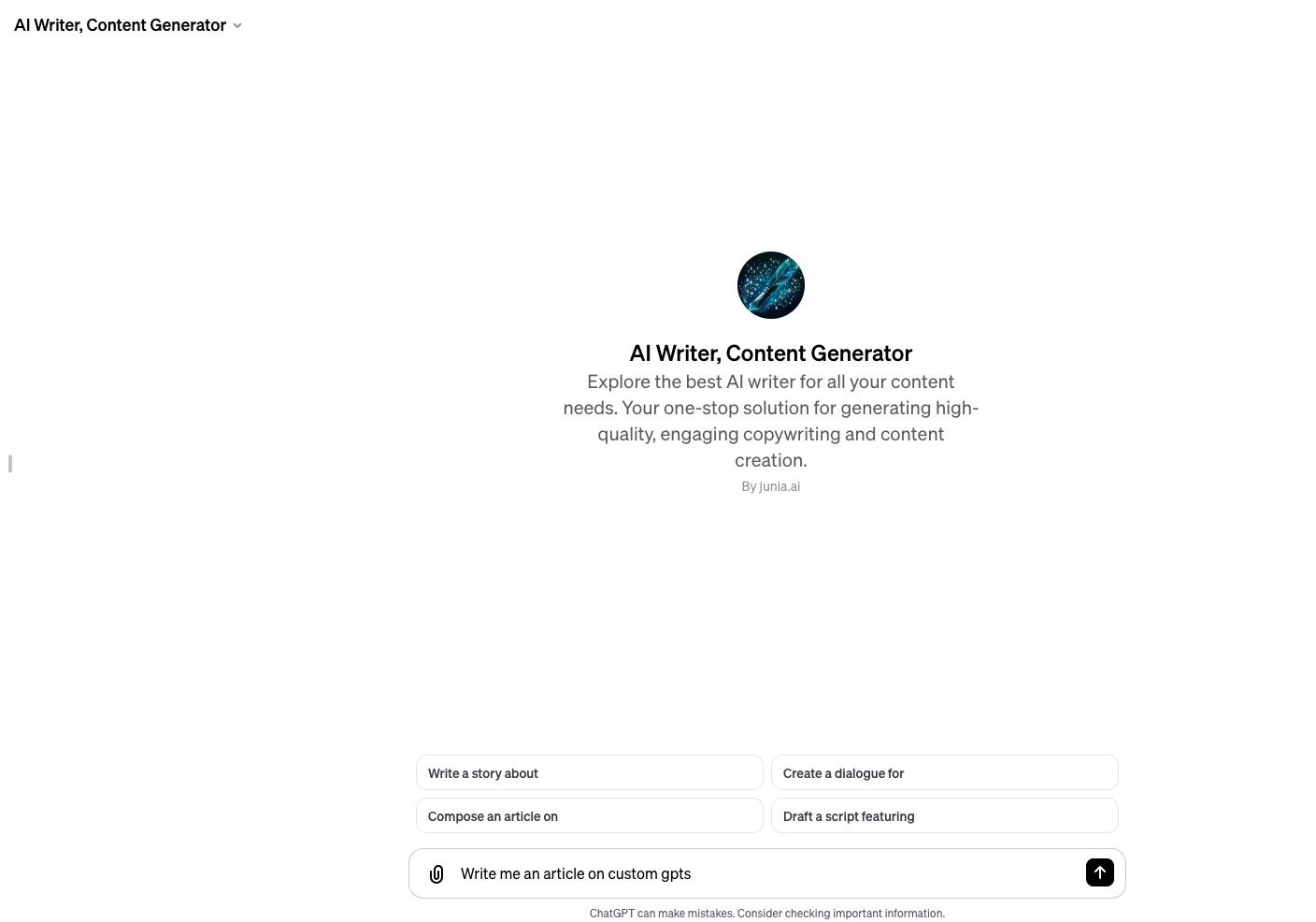
A blog content generator using a custom GPT can revolutionize your content creation process. You provide a topic or a keyword, and the AI model generates a comprehensive article for your blog post. This includes potential headings, sub-headings, and key points to cover under each section.
Example: Input: "The benefits of yoga"
Output:
This application can significantly reduce your planning time, allowing you to focus more on writing impactful content.
2. Article Rewriter
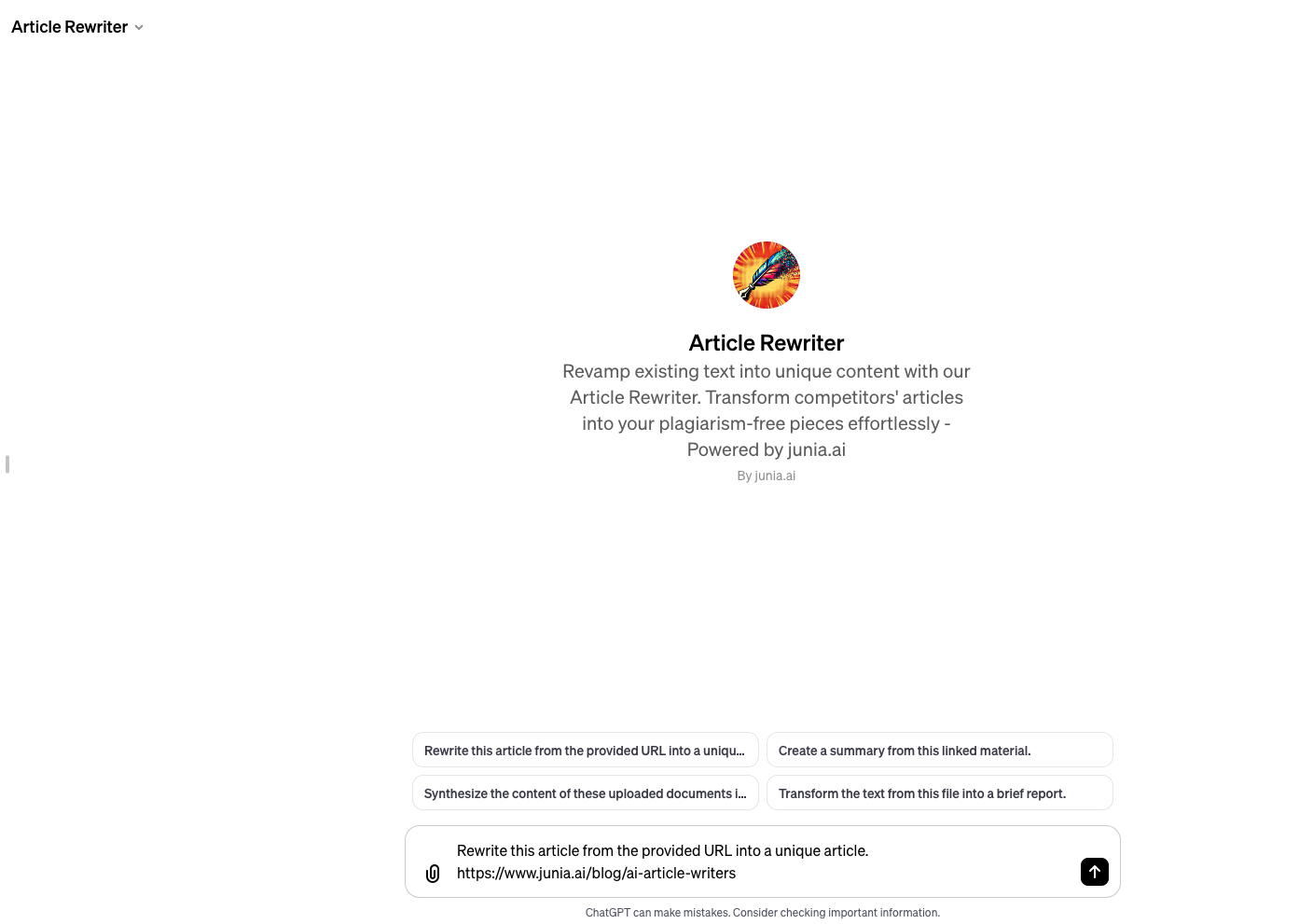 An Article Rewriter can be an invaluable tool for content creators, marketers, and SEO professionals. This custom GPT can take any existing article and rewrite it in a unique yet meaningful way while preserving the original intent and information.
An Article Rewriter can be an invaluable tool for content creators, marketers, and SEO professionals. This custom GPT can take any existing article and rewrite it in a unique yet meaningful way while preserving the original intent and information.
- Example:
- Input: "AI is transforming multiple sectors including healthcare, finance, and education."
- Output: "Multiple industries such as healthcare, finance, and education are experiencing significant changes due to AI advancements."
3. LogoGPT
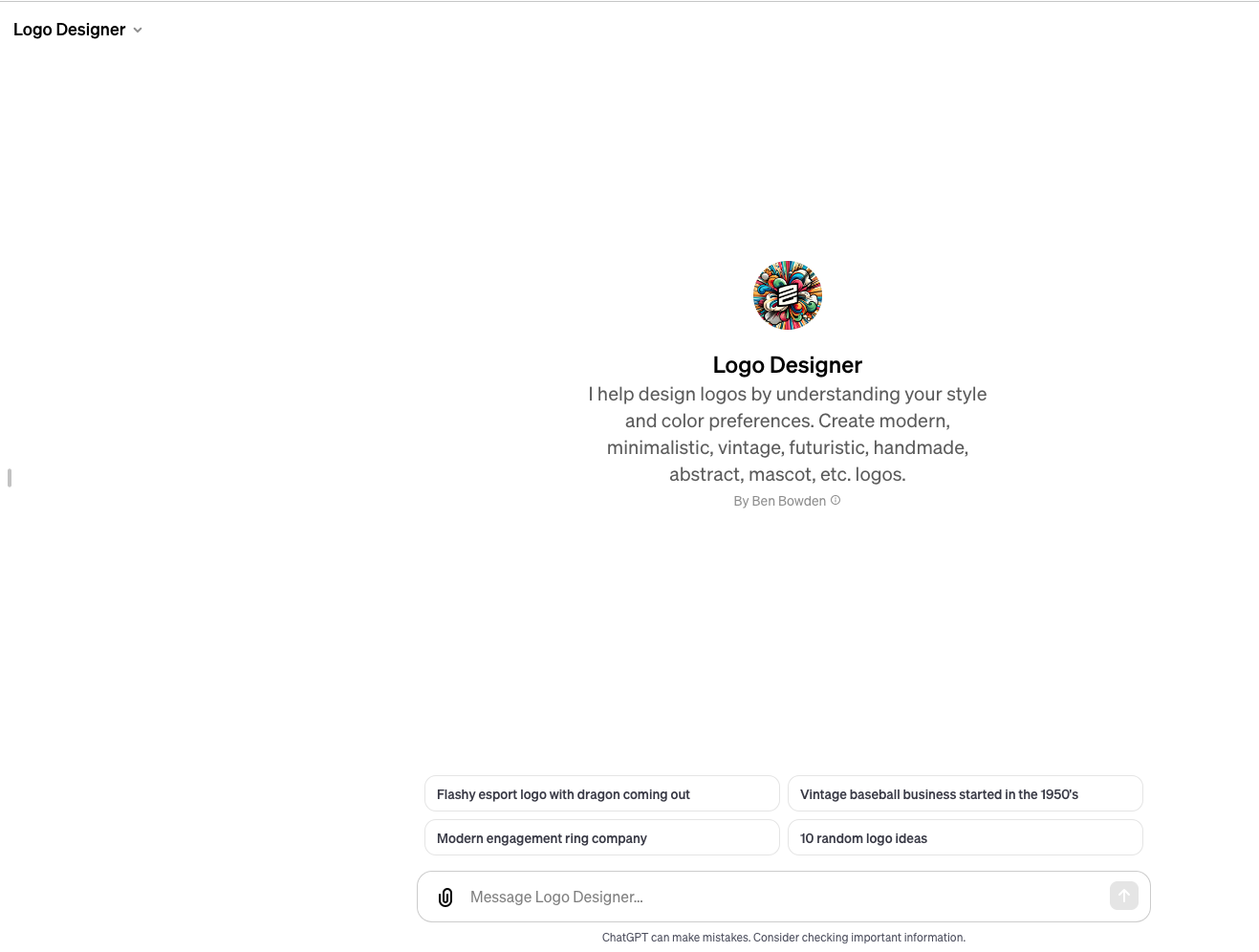
LogoGPT is a fascinating application that combines text-based prompts with AI-powered image generation capabilities to create unique logos.
- Example:
- Input: "Create a logo for 'Cafe Mocha', that features a coffee mug and has a vintage aesthetic."
- Output: [AI Generated Logo Image]
This could be a game-changer for brand developers and graphic designers who can use the AI to generate initial design concepts.
4. Relationship Guide GPT
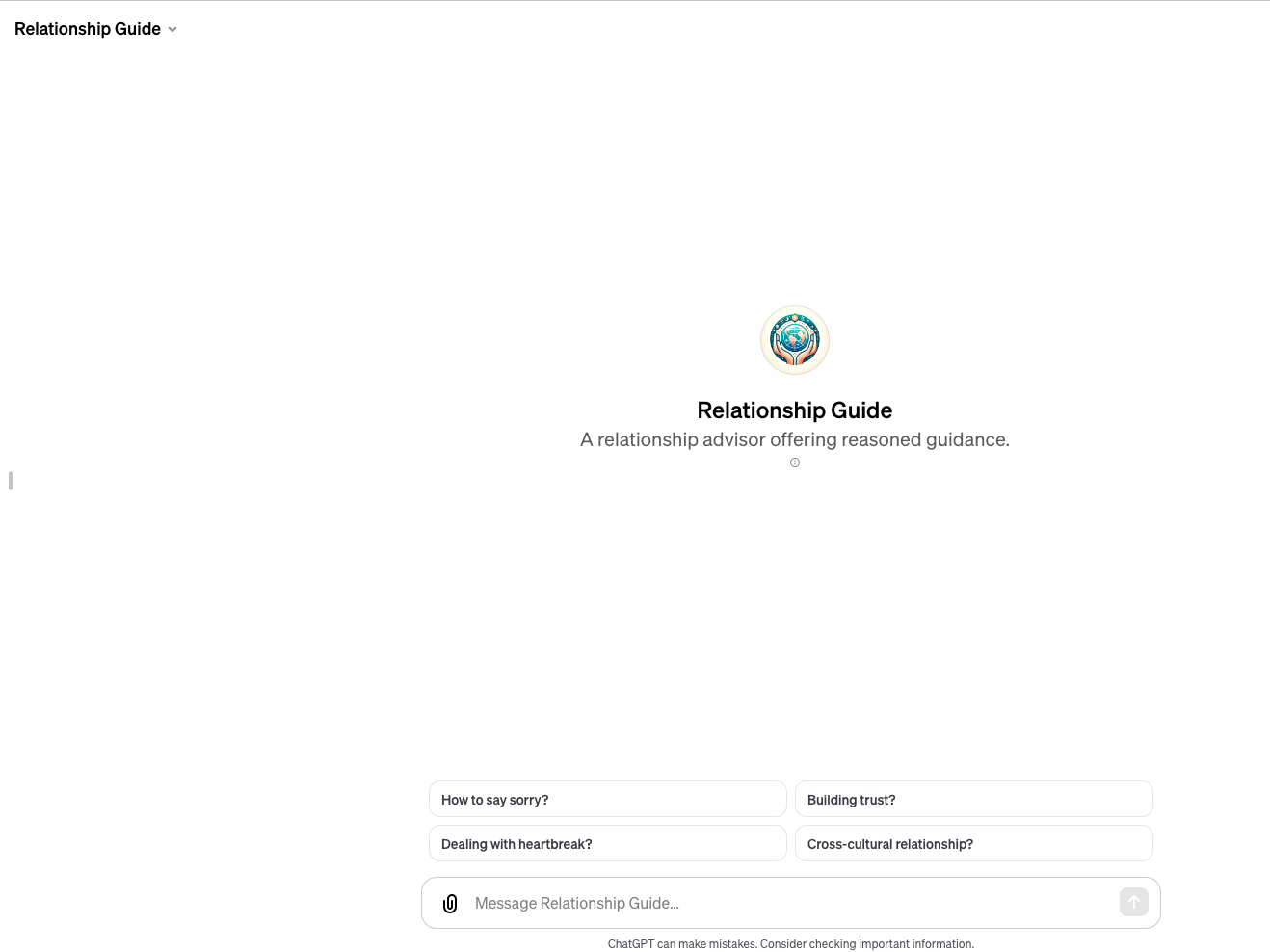
A Relationship Guide GPT can provide insights, suggestions, and guidance pertaining to various aspects of relationships. From communication advice to conflict resolution strategies, this AI can offer valuable assistance.
- Example:
- Input: "How to improve communication in a long-distance relationship?"
- Output:
- "1. Schedule Regular Video Calls: ... 2. Share Daily Updates: ... 3. Send Surprise Gifts: ..."
These examples demonstrate how custom GPTs can be tailored to meet diverse needs across industries. It's not just about convenience or automation; it's about empowering individuals and businesses with tools that enhance their capabilities and drive innovation.
Custom GPT for Parasite SEO
When a custom GPT is made publicly accessible, OpenAI assigns a unique URL to that specific transformer. This URL can be subsequently shared with others, providing widespread access to the AI tool. An intriguing advantage of this approach relates to the concept of Parasite SEO, a strategy designed to leverage high domain authority websites.
Understanding Parasite SEO
Parasite SEO is a method where you create content on a web platform with high domain authority, aiming to utilize that platform's trust and credibility with search engines to rank higher in search results.
Note: While Parasite SEO is a legitimate strategy, it's important to conform to ethical practices and not misuse it.
The Role of OpenAI's High Domain Authority
OpenAI boasts significant domain authority, which essentially refers to the search engine ranking strength of a website. This high ranking power makes it an attractive platform for implementing parasite SEO strategies.
- High Rankings: With OpenAI's robust domain authority, content associated with your custom GPT has the potential to achieve higher rankings in search results.
- Backlinking Opportunities: Inside your GPT content on OpenAI, you can direct users back to your own websites by integrating relevant hyperlinks. This drives traffic to your website, potentially increasing its visibility and reach.
Implementing Parasite SEO with Custom GPTs
To leverage your custom GPT for parasite SEO effectively, here are some steps you can take:
1. Develop a High-Quality GPT
Your GPT is more than just an AI tool; it's a representative of your brand. To ensure it positively reflects on you and engages users, focus on creating a high-quality, reliable, and user-friendly chatbot. Here are some tips to achieve this:
- Relevance: Make sure your GPT is relevant to your industry or niche. It should provide useful solutions or insights related to your field.
- Knowledgeability: Equip your GPT with comprehensive knowledge and information. This increases its credibility and makes it a valuable resource for users.
- User Experience: Prioritize ease of use and intuitive interaction. A user-friendly GPT encourages repeat usage and promotes positive word-of-mouth.
2. Brand Mentioning in Content Output
A powerful method to boost your visibility is to instruct your GPT to mention your brand in the content output. When implementing this strategy, bear in mind:
- Natural Integration: Brand mentions should feel organic within the content, not forced or out of place.
- Value Addition: Any time your brand is mentioned, it should be tied to helpful advice or insights. This way, readers associate your brand with value.
By following these steps, you can ensure that you're not just harnessing the power of OpenAI's domain authority, but also providing authentic value to users — a winning combination for successful Parasite SEO strategies.
By using custom GPTs in conjunction with Parasite SEO strategies, you can potentially amplify your online visibility and enhance website traffic, all while providing innovative AI tools to your audience.
Privacy and Safety Measures in GPTs
As we explore the world of GPTs, you might be wondering about how privacy and safety are handled in these AI models. It's important to ensure that your personal information is protected and that the interactions you have with GPTs are safe. Let's take a closer look at how privacy and safety are managed in GPTs.
Ensuring Privacy in GPTs
When you use a GPT, there may be instances where you share private or sensitive information. It is crucial that this information remains confidential. OpenAI takes privacy seriously and has implemented measures to safeguard user data.
- As a creator, you do not have access to the private conversations users have with the GPTs you create.
- This means that any personal data shared during these interactions is not accessible to third parties.
Implementing Safety Measures in GPTs
Safety is another important aspect when it comes to using AI models like GPTs. OpenAI has put in place mechanisms to address potential risks and ensure user safety.
- Automatic policy enforcement systems are used to monitor content generated by GPTs.
- These systems can detect and flag inappropriate content or behaviors that violate OpenAI's usage policies.
- If a violation is detected, appropriate action can be taken to address the issue.
How Policies are Enforced
OpenAI's automatic enforcement mechanisms play a crucial role in maintaining a safe environment for users interacting with GPTs. Here's an overview of how these mechanisms work:
- Content Monitoring: The system keeps track of all the content generated by the GPT.
- Policy Violation Detection: If any content violates OpenAI's usage policies, it is identified.
- Immediate Action: Once a violation is detected, prompt measures are taken to address it.
This process helps ensure that interactions with GPTs are secure and in compliance with OpenAI's guidelines.
By prioritizing privacy and safety, OpenAI has created a platform that allows users to engage with GPTs without worrying about their personal data being misused or being exposed to inappropriate content.
The Future of AI Customization with GPTs
The landscape of artificial intelligence (AI) is constantly changing, advancing at a pace that often outpaces our ability to understand its full implications. A key factor in this whirlwind of innovation is the progress and use of Generative Pretrained Transformers, or GPTs. As we explore the future of AI customization, the potential impact of GPT technology becomes more and more clear.
Increased Accessibility
One significant aspect lies in accessibility. Tools like GPT Builder and GPT Editor now exist, allowing individuals to create their own AI models without needing to know how to code. This 'democratization' of AI opens up a new era where anyone can customize AI, not just big tech companies or programming experts.
- Entrepreneurs can use custom AI to improve their businesses.
- Educators can employ AI to enhance teaching methods.
- Artists can utilize AI for creative projects.
- Innovators from all fields can leverage AI to solve complex problems.
By making it easier to create and modify GPT models, these tools have the potential to speed up the integration of AI across different industries.
Unprecedented Flexibility
GPTs also offer remarkable flexibility. They have the ability to learn from vast amounts of data and generate text that resembles human language based on specific prompts. This means GPTs can be tailored for a wide range of tasks:
- Drafting emails
- Writing articles
- Generating creative content
- Simulating human conversation
But it doesn't stop at text generation. GPTs are evolving to work with other types of data and perform complex functions, such as image generation and advanced data analysis. This level of versatility is poised to change how we think about and use artificial intelligence.
The Rise of Custom AI Marketplaces
Another exciting development is the emergence of platforms like the GPT Store. These platforms enable creators to sell their unique GPT models, potentially leading to an entire marketplace for specialized AI solutions.
The Journey Ahead
As we stand on the brink of this new frontier, it's evident that GPT technology could have a significant role in shaping the future of AI customization. But there is still much to discover and uncover about its full potential. As we continue to explore, innovate, and improve these tools, we are only just beginning the journey into the future of AI customization with GPTs. And it's bound to be an exciting one.
Conclusion
The potential residing within GPTs is vast and ever-expanding. They present a significant leap in the future of AI, transforming the way we interact with technology and broadening the horizon of AI customization.
These powerful models offer an exciting opportunity for every individual, regardless of their coding knowledge. With tools like GPT Builder and GPT Editor, creating custom ChatGPT models becomes an easy and accessible task.
Here are some ways you can take advantage of these models:
- Develop AI models tailored to your unique needs: Whether you want a chatbot for your website or a virtual assistant for your personal use, you can create models that serve your specific requirements.
- Experiment with different capabilities and functions: GPT Builder and GPT Editor allow you to tweak the model's behavior and responses, giving you the freedom to explore various possibilities.
- Monetize your creations on the GPT Store: If you come up with a particularly useful or innovative model, you can share it with others on the GPT Store and earn money from its usage.
The safety and privacy measures implemented by OpenAI ensure that your interactions with these models remain secure and controlled. From generating blog content outlines to re-writing articles, GPTs find relevance in various real-life applications.
You are the architect of your own technological journey, with endless possibilities at your fingertips. Dare to step into this new era of AI customization, where you have the power to shape your tools according to your vision.
With GPTs, the creation process does not end; it evolves. As we move forward, let's continue to explore, innovate, and redefine our relationship with technology together.
